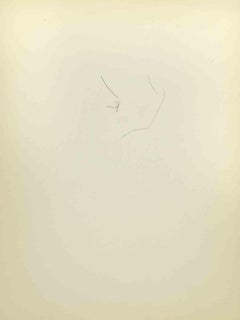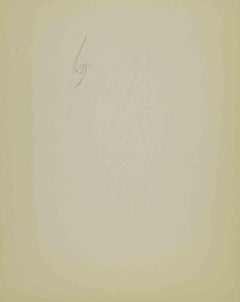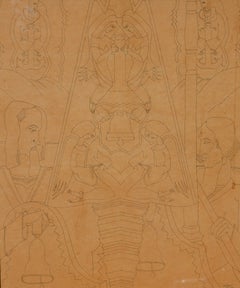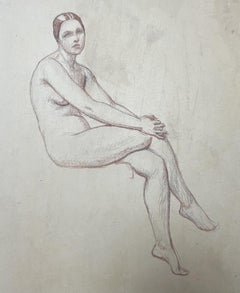Texture Portrait Drawings and Watercolors
to
2
1
Overall Width
to
Overall Height
to
3
1
2
1
3
1,115
3,438
1,963
1,948
1,656
1,237
713
661
625
497
443
358
143
101
88
83
76
68
58
54
2
2
1
1
1
Art Subject: Texture
Sketch for a Portrait - Drawing by Flor David - Mid 20th Century
By Flor David
Located in Roma, IT
Sketch for a Portrait is a drawing on paper realized in the Mid-20th Century by Flor David.
Good conditions.
Flor David (1891-1958) ): pseudonym of David Florence. Pastel painter....
Category
Mid-20th Century Modern Figurative Drawings and Watercolors
Materials
Pencil
Sketch for a Portrait - Drawing by Flor David - Mid 20th Century
By Flor David
Located in Roma, IT
Sketch for a Portrait is a drawing on paper realized in the Mid-20th Century by Flor David.
Good conditions.
Flor David (1891-1958) ): pseudonym of David Florence. Pastel painter...
Category
Mid-20th Century Modern Figurative Drawings and Watercolors
Materials
Pencil
Bell Ringers
By Karoly Fulop
Located in West Hollywood, CA
Presenting an original large pen and ink drawing by Hungarian/American artist Karoly Fulop.
"Bell Ringers", is an original pen and ink d...
Category
1930s Art Deco Figurative Drawings and Watercolors
Related Items
French Modern Drawing by Jean Hélion - Veil Homme
By Jean Hélion
Located in Paris, IDF
Veil Homme
1947
drawing
26,9 x 21 x 0,1 cm
Registered on the catalogue raisonné with inventory number : N°0252 cat. B
sold without frame
about Jean Hélion (April 21, 1904 – October ...
Category
1960s Modern Figurative Drawings and Watercolors
Materials
Paper, Pencil
Octave Denis Victor Guillonnet (1872 - 1967) A naked woman seated, drawing
Located in Paris, FR
Octave Denis Victor Guillonnet (1872 - 1967)
A naked young woman seated
Charcoal and red chalk on thin paper transfered on cardboard
49 x 39 cm
Framed : 55.5 x 45.5 cm
Octave Denis...
Category
1930s Art Deco Portrait Drawings and Watercolors
Materials
Chalk, Charcoal
1940s Charcoal and Pencil Portrait of a Man
Located in Arp, TX
Artist Unknown
"Tie and Glasses"
c. 1940s
Charcoal and pencil on paper
13.5"x17" site 19"x23" rustic wood frame
Unsigned
Category
1940s Modern Portrait Drawings and Watercolors
Materials
Paper, Charcoal, Carbon Pencil
Art Deco Girl with Car Mid-20th Century American Modernism Pin-Up Illustration
Located in New York, NY
Art Deco Girl with Car Mid-20th Century American Modernism Pin-Up Illustration
Arthur Rosenman Ross (1913 - 1981)
Deco Girl with Car, 1936
30 x 20 inches
Oil on Canvas Board
Signed Arthur ‘36 lower right
Provenance: Estate of the artist.
BIO
Arthur Rosenman Ross was a key figure in automotive design at General Motors during America's "Golden Age" of auto design, the 1930's through the 1950s.
He attended the Art Institute of Chicago from age 17, exhibiting a special interest for automotive renderings and the female figure.
In 1934, he changed his name from Rosenman to Ross, fearing his Jewish ancestry could prejudice his career prospects. At age 20, he turned down job offers from MGM Studios in Hollywood
and Duesenberg to work at General Motors alongside the Legendary Harley Earl in 1935.
He was hand picked by Mr. Earl and assigned to GM's War and Camouflage Division in 1937 through WW2.
It was during this pivotal period in which he executed some extraordinary military aircraft artworks, likely used between GM and America's military aeronautics companies in design preparation for WW2. General Motors played an important role in helping America's aircraft manufacturers preceding and during the war.
Just after the war in 1945, Mr. Ross was rewarded by GM, being made Chief Designer of Cadillac, then two years later becoming Chief at Oldsmobile until his retirement in 1959.
He was in large part responsible for some of GM's classic Cadillac designs such as the Cadillac Sixty Special, Fleetwood, LaSalle and GM's first concept car, the extraordinary Buick Y-Job.
Mr. Ross was an exceptionally charismatic and vivacious man who quite by chance, befriended His idol, Salvador Dali at GM in 1955.
They talked about art, cars and girls late into the evening, according to his son, Carter Ross.
He had a gift in rendering the erotic arts...
Category
1930s Art Deco Figurative Drawings and Watercolors
Materials
Oil, Board
Original French Art Deco Gouache Illustration Drawing by J. Hilly
Located in Atlanta, GA
An original Art Deco illustration hand-painted with ink and gouache on paper. The drawing features two elegant women with large windows and drapery in the background. This image was ...
Category
1930s Art Deco Figurative Drawings and Watercolors
Materials
Paper, Ink, Gouache
H 15.57 in W 12 in D 2 in
Lucien Victor Guirand de Scevola (1871-1950) Portrait of a boy, signed pastel
Located in Paris, FR
Lucien-Victor Guirand de Scevola (1871-1950)
Portrait of a boy
Signed lower left
Pastel on paper
28 x 23 cm
Framed : 63 x58 cm
Guirand de Scévola is particularly renowned for his...
Category
1930s Art Deco Portrait Drawings and Watercolors
Materials
Pastel
" Elégante aux perles " .Carlton . Cannes
By René Gruau
Located in CANNES, FR
René Gruau ( 1909 - 2004 )
" Elégante aux perles " . 1950 .
Dessin Original et unique
graphite et fusain sur papier . Signé.
format feuille : 83 x 50 cm
feuille globale : 92 x 6...
Category
1950s Art Deco Figurative Drawings and Watercolors
Materials
Archival Paper
Young man in a toga elegant man Latin American hyperrealist Hockney style
Located in Norwich, GB
Superb original drawing in coloured conté pencils, heightened with white on oatmeal coloured vergé paper by Claudio Bravo. The work was created during the artist's Moroccan period, a...
Category
1970s Modern Portrait Drawings and Watercolors
Materials
Conté, Laid Paper, Color Pencil
H 30.32 in W 24.02 in D 0.4 in
"Contemplation"
Located in Lambertville, NJ
Jim’s of Lambertville is proud to offer this artwork by:
Gershon Benjamin (1899-1985)
An American Modernist of portraits, landscapes, still lives, and the urban scene, Gershon Benj...
Category
1920s Modern Figurative Drawings and Watercolors
Materials
Graphite
beggars spanish modernism colored pencils
Located in Barcelona, Barcelona
Ricard Opisso - Beggars - Colored pencils
Measurements drawing 21x31cm.
Frame measures 39x48 cm.
Damaged paper at bottom.
Anti-reflective glass.
Son of Alfredo Opisso y Viñas, journalist, historian and critic, and of Antonia Sala y Gil, his sister Regina Opisso, was also a writer. He comes from an enlightened family full of artists. His paternal grandfather was Josep Opisso y Roig, journalist and director of the Diari de Tarragona, father of the also writers Antonia Opisso y Viña and Antoni Opisso y Viña. His maternal great-grandfather was the painter Pere Pau Montaña, his maternal grandfather the fabulist Felipe Jacinto Sala and his maternal uncle, the painter Emilio Sala y Francés. His nephew was Arturo Llorens y Opisso, a writer better known under his pseudonym Arturo Llopis.
Although he was born in Tarragona, his family moved to Barcelona when Opisso was only two years old. In modernist Barcelona at the end of the 19th century, Opisso worked as an assistant to Antonio Gaudí in the works of the Sagrada Familia in Barcelona since 1892. He was linked to the group Els Quatre Gats, along with Ramón Casas...
Category
1940s Modern Portrait Drawings and Watercolors
Materials
Color Pencil
Black Panther Trials - Civil Rights Movement Police Violence African American
Located in Miami, FL
The Black Panther Trials - In this historically significant work, African American Artist Vicent D. Smith functions as an Art Journalist/ Court Reporter as much as a
Artist. Here, he depicts, in complete unity, 21 Black Panther Protestors raising their fist of defiance at the White Judge. Smith's composition is about utter simplicity, where the Black Panther Protestors are symmetrically lined up in a confrontation with a Judge whose size is exaggerated in scale. Set against a stylized American Flag, the supercilious Judge gazes down as the protesters as their fists thrust up. Signed Vincent lower right. Titled Panter 21. Original metal frame. Tape on upper left edge of frame. 255 . Panther 21. Framed under plexi.
_____________________________
From Wikipedia
In 1969-1971 there was a series of criminal prosecutions in New Haven, Connecticut, against various members and associates of the Black Panther Party.[1] The charges ranged from criminal conspiracy to first-degree murder. All charges stemmed from the murder of 19-year-old Alex Rackley in the early hours of May 21, 1969. The trials became a rallying-point for the American Left, and marked a decline in public support, even among the black community, for the Black Panther Party
On May 17, 1969, members of the Black Panther Party kidnapped fellow Panther Alex Rackley, who had fallen under suspicion of informing for the FBI. He was held captive at the New Haven Panther headquarters on Orchard Street, where he was tortured and interrogated until he confessed. His interrogation was tape recorded by the Panthers.[2] During that time, national party chairman Bobby Seale visited New Haven and spoke on the campus of Yale University for the Yale Black Ensemble Theater Company.[3] The prosecution alleged, but Seale denied, that after his speech, Seale briefly stopped by the headquarters where Rackley was being held captive and ordered that Rackley be executed. Early in the morning of May 21, three Panthers – Warren Kimbro, Lonnie McLucas, and George Sams, one of the Panthers who had come East from California to investigate the police infiltration of the New York Panther chapter, drove Rackley to the nearby town of Middlefield, Connecticut. Kimbro shot Rackley once in the head and McLucas shot him once in the chest. They dumped his corpse in a swamp, where it was discovered the next day. New Haven police immediately arrested eight New Haven area Black Panthers. Sams and two other Panthers from California were captured later.
Sams and Kimbro confessed to the murder, and agreed to testify against McLucas in exchange for a reduction in sentence. Sams also implicated Seale in the killing, telling his interrogators that while visiting the Panther headquarters on the night of his speech, Seale had directly ordered him to murder Rackley. In all, nine defendants were indicted on charges related to the case. In the heated political rhetoric of the day, these defendants were referred to as the "New Haven Nine", a deliberate allusion to other cause-celebre defendants like the "Chicago Seven".
The first trial was that of Lonnie McLucas, the only person who physically took part in the killing who refused to plead guilty. In fact, McLucas had confessed to shooting Rackley, but nonetheless chose to go to trial.
Jury selection began in May 1970. The case and trial were already a national cause célèbre among critics of the Nixon administration, and especially among those hostile to the actions of the FBI. Under the Bureau's then-secret "Counter-Intelligence Program" (COINTELPRO), FBI director J. Edgar Hoover had ordered his agents to disrupt, discredit, or otherwise neutralize radical groups like the Panthers. Hostility between groups organizing political dissent and the Bureau was, by the time of the trials, at a fever pitch. Hostility from the left was also directed at the two Panthers cooperating with the prosecutors. Sams in particular was accused of being an informant, and lying to implicate Seale for personal benefit.
In the days leading up to a rally on May Day 1970, thousands of supporters of the Panthers arrived in New Haven individually and in organized groups. They were housed and fed by community organizations and by sympathetic Yale students in their dormitory rooms. The Yale college dining halls provided basic meals for everyone. Protesters met daily en masse on the New Haven Green across the street from the Courthouse (and one hundred yards from Yale's main gate). On May Day there was a rally on the Green, featuring speakers including Jean Genet, Abbie Hoffman, Jerry Rubin, and John Froines (an assistant professor of chemistry at the University of Oregon). Teach-ins and other events were also held in the colleges themselves.
Towards midnight on May 1, two bombs exploded in Yale's Ingalls Rink, where a concert was being held in conjunction with the protests.[4] Although the rink was damaged, no one was injured, and no culprit was identified.[4]
Yale chaplain William Sloane Coffin stated, "All of us conspired to bring on this tragedy by law enforcement agencies by their illegal acts against the Panthers, and the rest of us by our immoral silence in front of these acts," while Yale President Kingman Brewster Jr. issued the statement, "I personally want to say that I'm appalled and ashamed that things should have come to such a pass that I am skeptical of the ability of a Black revolutionary to receive a fair trial anywhere in the U.S." Brewster's generally sympathetic tone enraged many of the university's older, more conservative alumni, heightening tensions within the school community.
As tensions mounted, Yale officials sought to avoid deeper unrest and to deflect the real possibility of riots or violent student demonstrations. Sam Chauncey has been credited with winning tactical management on behalf of the administration to quell anxiety among law enforcement and New Haven's citizens, while Kurt Schmoke, a future Rhodes Scholar, mayor of Baltimore, MD and Dean of Howard University School of Law, has received kudos as undergraduate spokesman to the faculty during some of the protest's tensest moments. Ralph Dawson, a classmate of Schmoke's, figured prominently as moderator of the Black Student Alliance at Yale (BSAY).
In the end, compromises between the administration and the students - and, primarily, urgent calls for nonviolence from Bobby Seale and the Black Panthers themselves - quashed the possibility of violence. While Yale (and many other colleges) went "on strike" from May Day until the end of the term, like most schools it was not actually "shut down". Classes were made "voluntarily optional" for the time and students were graded "Pass/Fail" for the work done up to then.
Trial of McLucas
Black Panther trial sketch...
Category
1970s American Modern Figurative Drawings and Watercolors
Materials
Watercolor, Pen, Pencil, Paper
Art Deco Buick Car 1937 Design Mid-20th Century American Modern Illustration
Located in New York, NY
Art Deco Buick Car 1937 Design Mid-20th Century American Modern Illustration
Arthur Rosenman Ross (1913 - 1981)
1937 Buick
10 1/2 x 19 inches (sight)
11 5/8 x 23 inches (sheet)
Go...
Category
1930s Art Deco Figurative Drawings and Watercolors
Materials
Paper, Gouache



